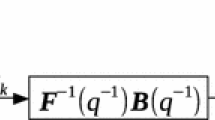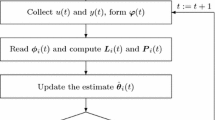Abstract
In this paper, we consider the structure and parameter identification problem for Bayesian Hammerstein system. A structure identification algorithm is proposed, in which the system order, system parameters and regularization parameters are all unknown in the considered system. The joint posterior distribution of system parameters and the value of basis functions \(k\) are obtained via sampling theory. The proposed identification algorithm is based on the reversible jump Markov chain Monte Carlo method. There are two main characteristics of the algorithm: (i) By using the birth move and death move strategy, the parameter \(k\) is searched quickly in the number of basis functions space until the suitable value of \(k\) is found. (ii) The distributions of system parameters are changed with the value of \(k\) in the Bayesian framework, and the parameters are successfully found after the value of \(k\) is stable. Two examples are provided to show the effectiveness of the proposed algorithm. The performances of the algorithm are validated with the results of statistical analyses including parameter estimate error, MSE, NRMSE, MAD, Theils inequality coefficient, etc.








Similar content being viewed by others
References
Ding, F., Peter Liu, X.P., Liu, G.J.: Identification methods for Hammerstein nonlinear systems. Dig. Signal Process. 21, 215–238 (2011)
Ding, F., Shi, Y., Chen, T.W.: Gradient-based identification methods for Hammerstein nonlinear ARMAX models. Nonlinear Dyn. 45(1), 31–43 (2005)
Li, J.H., Ding, F., Hua, L.: Maximum likelihood Newton recursive and the Newton iterative estimation algorithms for Hammerstein CARAR systems. Nonlinear Dyn. 75(1), 235–245 (2014)
Ding, J., Ding, F., Peter Liu, X.P., Liu, G.J.: Hierarchical least squares identification for linear SISO systems with dual-rate sampled-data. IEEE Trans. Autom. Control 56(11), 2677–2683 (2011)
Liu, X.G.: Least squares based iterative identification for a class of multirate systems. Automatica 46(3), 549–554 (2010)
Han, X.Q., Xie, L., Ding, F., Liu, X.G.: Hierarchical least-squares based iterative identification for multivariable systems with moving average noises. Math. Comput. Model. 51(9–10), 1213–1220 (2010)
Zhang, Z.N., Ding, F., Liu, X.G.: Hierarchical gradient based iterative parameter estimation algorithm for multivariable output error moving average systems. Comput. Math. Appl. 61(3), 672–682 (2011)
Greblicki, W.: Nonlinearity estimation in Hammerstein systems based on ordered observations. IEEE Trans. Signal Process. 44(5), 1224–1233 (1996)
Haber, R., Unbehauen, H.: Structure identification of nonlinear dynamic systems—a survey of input/output approaches. Automatica 26(4), 651–677 (1990)
Prakriya, S., Hatzinakos, D.: Blind identification of linear subsystems of LTI-ZMNL-LTI models with cyclostationary inputs. IEEE Trans. Signal Process. 45(8), 2023–2036 (1997)
Chaudhary, N.I., Raja, M.A.Z., Khan, J.A., Aslam, M.S.: Identification of input nonlinear control auto-regressive systems using fractional signal processing approach. Sci World J. doi:10.1155/2013/467276 (2013)
Sun, J.L., Liu, X.G.: A novel APSO-aided maximum likelihood identification method for Hammerstein systems. Nonlinear Dyn. 73(1–2), 449–462 (2013)
Narendra, K.S., Gallman, P.G.: An iterative method for the identification of nonlinear systems using a Hammerstein model. IEEE Trans. Autom. Control 11(3), 546–550 (1966)
Chang, F., Luus, R.: A noniterative method for identification using Hammerstein model. IEEE Trans. Autom. Control 16, 464–468 (1971)
Bai, E.: An optimal two-stage identification algorithm for Hammerstein-Wiener nonlinear systems. Automatica 34(3), 333–338 (1998)
Chang, F., Luus, R.: A noniterative method for identification using Hammerstein model. IEEE Trans. Automat. Control 16(5), 464–468 (1971)
Bilings, S.A., Fakhouri, S.Y.: Identification of a class of nonlinear systems using correlation analysis. Proc. Inst. Elect. Eng. 125(7), 691–697 (1978)
Bai, E.W., Fu, M.: A blind approach to Hammerstein model identification. IEEE Trans. Signal Process. 50(7), 1610–1619 (2002)
Zahoor, R.M.A., Qureshi, I.M.: A modified least mean square algorithm using fractional derivative and its application to system identification. Eur. J. Sci. Res 35(1), 14–21 (2009)
Aslam, M.S., Zahoor, R.M.A.: A new adaptive strategy to improve online secondary path modeling in active noise control systems using fractional signal processing approach. Signal Process. J. doi:10.1016/j.sigpro.2014.04.012
Shah, S.M., Samar, R., Raja, M.A.Z., Chambers, J.A.: Fractional normalized filtered-error least mean squares algorithm for application in active noise control systems. Electron. Lett. 50(14), 973–975 (2014)
Zahoor, R.M.A., Chaudhary, N.I.: Two-stage fractional least mean square identification algorithm for parameter estimation of CARMA systems. Signal Process. J. doi:10.1016/j.sigpro.2014.06.015
Akaike, H.: A new look at the statistical model identification. IEEE Trans. Autom. Control 19, 716–723 (1974)
Rissanen, J.: Modeling by shortest data description. Automatica 14, 465–478 (1978)
Schwarz, G.: Estimating the dimension of a model. Ann. Stat. 6, 461–467 (1985)
Ninness, B., Henriksen, S.: Bayesian system identification via Markov chain Monte Carlo techniques. Automatica 46, 40–51 (2010)
Baldacchino, T., Anderson, S.R., Kadirkamanathan, V.: Computational system identification for Bayesian NARMAX modelling. Automatica 49, 2641–2651 (2013)
redrik Lindstena, F., Schon, T.B., Jordanb, M.I.: Bayesian semiparametric Wiener system identification. Automatica 49, 2053–2063 (2013)
Robert, C.P., Ryde, T., Titterington, D.M.: Bayesian inference in hidden Markov models through jump Markov chain Monte Carlo. J. R. Stat. Soc. Ser. B 62(1), 57–75 (2000)
Bernardo, J.M., Smith, A.F.M.: Bayesian Theory. Wiley, New York (1994)
Vermaak, J., Andrieu, C., Doucet, A., Godsill, S.J.: Reversible jump Markov chain Monte Carlo strategies for Bayesian model selection in autoregressive processes. J. Time Ser. Anal. 25(6), 785–809 (2004)
Hastings, W.K.: Monte Carlo sampling methods using Markov Chains and their applications. Biometrika 57(1), 97–109 (1970)
Ninness, B., Henriksen, S.: Bayesian system identification via Markov chain Monte Carlo techniques. Automatica 46(1), 40–51 (2010)
Vermaak, J., Andrieu, C., Doucet, A., Godsill, S.J.: Bayesian model selection of autoregressive processes. Technical Report. University of Cambridge, Department of Engineering, Cambridge, UK (2000)
Green, P.J.: Reversible jump Markov chain Monte Carlo computation and Bayesian model determination. Biometrika 82(4), 711–732 (1995)
Besag, J.: A candidate’s formula—a curious result in Bayesian prediction. Biometrika 76, 183 (1989)
Acknowledgments
This paper is partially supported by the Science Fund for Hundred Excellent Innovation Talents Support Program of Hebei Province, Doctoral Fund of Ministry of Education of China (20121333110008), Hebei Province Applied Basis Research Project (13961806D), Hebei Province Development of Social Science Research Project (201401315) and the National Natural Science Foundation of China (61273260, 61290322, 61273222, 61322303).
Author information
Authors and Affiliations
Corresponding author
Rights and permissions
About this article
Cite this article
Zhang, L., Hua, C. & Guan, X. Structure and parameter identification for Bayesian Hammerstein system. Nonlinear Dyn 79, 1847–1861 (2015). https://doi.org/10.1007/s11071-014-1779-1
Received:
Accepted:
Published:
Issue Date:
DOI: https://doi.org/10.1007/s11071-014-1779-1




